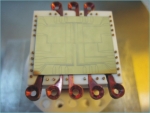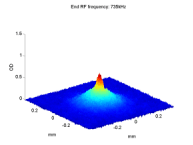Interferometry
Sagnac interferometry
When a wave interferes around a closed, rotating ring, it develops a phase shift
that is proportional to the angular frequency of the rotation and to the area of the ring.
This so-called Sagnac effect is an analogue of the famous Aharonov-Bohm effect in electromagnetism.
A Sagnac interferometer could be an airborne navigation device. Sagnac interferometers
using matter waves have been built; they show precisions beyond conventional
light-wave interferometers even in their preliminary design. Our theoretical investigation
concentrates on novel schemes for matter-wave Sagnac interferometry.
We use such principles as phase rigidity and mutiply winding paths in order to design
robust and precise miniaturized interferometors.
[Using time-reversal symmetry for sensitive incoherent matter-wave Sagnac interferometry
Y. Japha, O. Arzouan, Y. Avishai and R. Folman, Phys. Rev. Lett. 99, 060402 (2007)]
Coherence of atoms in a double well
Matter waves of many atoms usually satisfy a nonlinear Schroedinger equation, the Gross-Pitaevskii equation, which treats the interactions among the atoms as a mean field potential. However, when an atomic cloud is split by a potential barrier, the parts of the cloud may lose relative phase coherence and behave as independent modes. The properties of the ground state, the dynamics of the relative phase between the parts, and also the effect of temperature or external noise on the coherence, are open questions; the answers will help experimentalists demonstrate the interference of ultracold atoms in a trapping or guiding potential.

